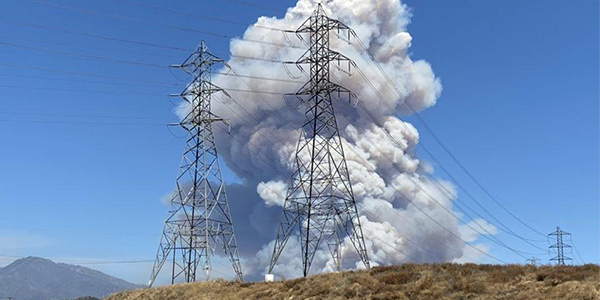WECC waded into California’s wildfire troubles Thursday in an effort to understand how catastrophic blazes could affect regional grid stability and what can be done to protect the bulk power system.
In the first in a series of webinars planned this month, major utilities and transmission operators, including Southern California Edison and Pacific Gas and Electric, briefed WECC stakeholders on fire-prevention planning.
The state’s summer and fall fire season has begun, with several large wildfires burning in Southern California. The largest, the Apple Fire, had burned more than 32,000 acres and was 40% contained as of Sunday afternoon, the California Department of Forestry and Fire Protection reported.
Massive fires sparked by utility equipment killed dozens of people and destroyed thousands of homes in Northern and Southern California during fire seasons in the past three years.
“The timing of this presentation is such that I don’t need to spend a lot of time explaining the risk or the severity,” said Tom Brady, senior manager of emergency response at SCE. “We know that California does have a serious wildfire problem, and it’s something that continues to get worse.
“I recall growing up and remembering a time when there was a start and an end to fire season,” Brady said. But “it seems with today’s current events, that window is extending, and it’s really difficult to say there’s a fire season anymore because there’s always a risk for ignition and spread.”
Ten of the state’s 20 most destructive wildfires have happened in the past five years, posing an “existential crisis” for investor-owned utilities, he said.
‘Extreme Natural Events’
In a June report, WECC cited the West’s propensity for epic natural disasters as one of the gravest threats to the grid. (See WECC Board Adopts Reliability Risk List.)
WECC should “prepare for and evaluate impacts on the bulk power system caused by extreme natural events,” such as wildfires, drought, flooding and earthquakes, it said, with an emphasis on sharing best practices and lessons learned from individual state and utility experiences across the Western Interconnection.
On Thursday, utility representatives described efforts to head off wildfires, starting this fall.
Brady said SCE had installed 650 miles of insulated wire in the areas at highest risk of fire in its sprawling service territory. The utility plans to install a total of 1,200 miles of covered conductor by the end of this year, he said.
SCE also placed 1,200 fuses and remote-controlled sectionalizing devices on its system to interrupt power more quickly and prevent ignitions.
Sectioning off its grid also allows SCE to limit the extent of public safety power shutoffs (PSPS) — the intentional blackouts California IOUs use to keep electrical equipment from starting fires during dry windy conditions.
“We’re able to minimalize, sectionalize and isolate the smallest footprint possible so that we’re not interrupting a lot of customers,” he said.
During a weather event the weekend of Aug. 1, SCE warned hundreds of customers in Kern County they might be subject to power shutoffs. Sectionalizing allowed the utility to limit the number of affected customers to 17, Brady said.
PG&E said it is following the lead of SCE and San Diego Gas & Electric by installing hundreds of weather stations and hilltop cameras in its high-risk fire zones, which make up about half the utility’s 70,000-square-mile service territory.
Matt Pender, director of PG&E’s community wildfire safety program, told the WECC audience that 70% of ignitions in its territory resulted from vegetation contacting power lines (48%) or equipment failure (22%).
The November 2018 Camp Fire, the deadliest in state history, started when a PG&E conductor fell, igniting dry vegetation below. Investigators determined a 100-year-old C-hook had broken after decades of wear, dropping the high-voltage line. (See Ancient C Hook, Financial Manipulation Caused Camp Fire.)
Pender said PG&E had inspected every asset in its high-risk fire areas during six months in 2019. The work, helped by drones and machine learning, might have taken five years under PG&E’s “old regime” of line inspections, he said.
Planes equipped with infrared sensors can now inspect lines at night, he said.
The utility also is using sectionalizing devices, as well as placing generators at substations, to limit the scope and duration of PSPS events this fall. Last year, PG&E blacked out hundreds of thousands of customers for up to a week at a time during multiple events. (See California PUC Approves Microgrids, Fire Plans.)
The company’s goal with PSPS is to “to make them smaller, shorter and smarter this year,” Pender said.
Upcoming Webinars
WECC said its next wildfire webinar, on Aug. 13, will be an in-depth “technical exploration into wildfire preparedness and the bulk power system, including system hardening, technology deployment, advanced weather modeling, weather stations, predictive fire spread modeling and high-definition camera installations.”
A third webinar Aug. 20 will examine the “mitigation, right-of-way and vegetation-management aspects of wildfire preparedness. The webinar will explore actions that entities may take to stay compliant and assist in the preparation and prevention of wildfires.”



